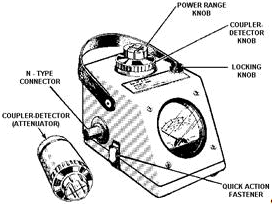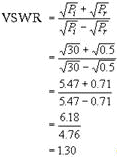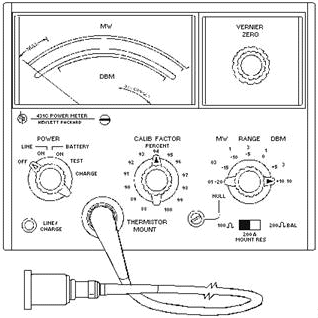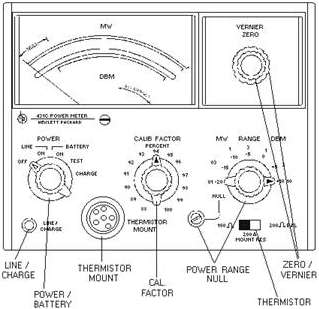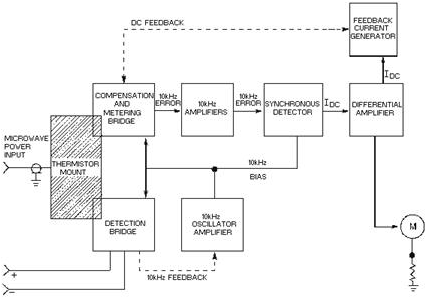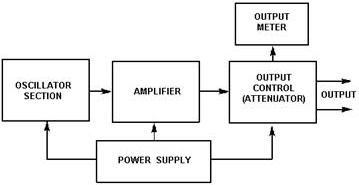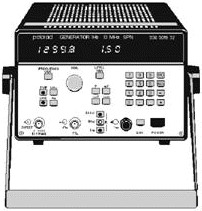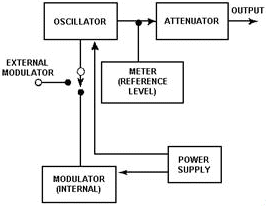Module 16 - Introduction to Test Equipment |
||||||||||||||||||||||||||||||||||||||||||||||||||
|
Module 16 − Introduction to Test Equipment Pages i, 1−1, 1−11, 1−21, 2−1, 2−11, 2−21, 3−1, 3−11, 3−21, 3−31, 4−1, 4−11, 4−21, 5−1, 5−11, 5−21, 5−31, 6−1, 6−11, 6−21, 6−31, 6−41, Index
Chapter 5
Special-APPLICATION Test Equipment
Learning Objectives
Upon completing this chapter, you should be able to:
1. Explain the theory of operation of two types of power meters.
2. Describe the purpose of the controls and indicators found on power meters.
3. Describe the proper procedure for taking power measurements for incident and reflected energy.
4. Describe the uses and purposes of the controls and indicators found on the signal generator.
5. Explain the theory of operation of a typical frequency counter.
6. Describe the uses and purposes of the controls and indicators found on the frequency counter.
7. Explain the uses and purposes of the controls and indicators found on the Huntron Tracker 2000.
8. Describe the proper procedures for troubleshooting with a logic probe.
9. Describe the proper procedures for troubleshooting using the Huntron Tracker 2000.
Introduction
In chapters 3 and 4, you studied the more common pieces of test equipment. As a technician, you will routinely use this test equipment to troubleshoot and perform maintenance on electronic equipment. However, the equipments you will study in this chapter may or may not be found in your shop. This is because these equipments have specific or specialized uses. Unless your rating is involved with the equipment with which they are used, you may not have reason to use them. They are presented here so that you will be familiar with their overall function should the need arise. The equipments you will study in this chapter are power meters, signal generators, frequency counters, and integrated circuit-testing devices.
Power METERS
As a technician, you will use a Power METER to measure power. There are various types of power meters, some of which are called WATTMETERS. Figure 5-1 shows the AN/URM-120 wattmeter, which is one type of power meter commonly used in the Navy. This particular power meter measures power directly; that is, you connect it directly between the transmitter output (rf source) and the load, most likely an antenna.
5-1
Figure 5-1. - Wattmeter (AN/URM-120).
Other types of power meters measure power indirectly; that is, they sample power in other ways - but not by being placed directly between the output of the transmitter and the load. Let's discuss the direct-measuring power meter first; then we'll talk about an indirect-measuring power meter.
Direct-MEASURING Power METERS
The direct-measuring power meter is designed to measure incident (forward) and reflected (reverse) RF power from 50 to 1,000 watts at 2 MHz to 30 MHz and 10 to 500 watts at 30 MHz to 1,000 MHz. Three separate COUPLER-DETECTORS (sometimes called ATTENUATORS), each rated to cover a portion of the frequency and power ranges, are provided with the wattmeter. These devices couple the RF signal into the wattmeter and detect the signal. The coupler-detector knob projects through the top of the wattmeter case, as shown on the AN/URM-120 wattmeter in figure 5-1.
A nameplate on the top of the Power RANGE knob indicates the power range. The Power RANGE knob can be rotated 360º to the desired power range. The coupler-detector rotates 180º inside the metal case for either forward or reverse power measurements. Also located inside the metal case are the indicating meter and cable for interconnecting the meter to the coupler-detector. The LOCKING knob locks the coupler-detector and Power RANGE knobs in place.
Two N-TYPE connectors (one male and one female) are located on either side of the wattmeter case to connect the instrument between the power source and the load. The upper and lower parts of the wattmeter are held together with quick-action fasteners, which permit easy access to the inside of the wattmeter.
Power measurements are made by inserting the proper coupler-detector and connecting the wattmeter in the transmission line between the load and the RF power source. To measure incident power with the wattmeter, rotate the arrow on the COUPLER-DETECTOR knob toward the load, and position the Power RANGE knob for peak meter reading. To measure reflected power, position the arrow toward the RF power source.
In effect, rotating the coupler-detector causes the coupler to respond only to a wave traveling in a particular direction, either to (incident) or from (reflected) the load. It will be unaffected by a wave traveling in the opposite direction. a diode rectifier in the coupler rectifies the energy detected by the
5-2 coupler. This detected RF energy is measured across a known impedance to obtain either incident or reflected power.
Operating the Wattmeter
Always de-energize and tag the RF power source before measuring incident power. Insert the proper coupler-detector for the RF power being measured into the wattmeter case. Remove the wire shunt (not shown in figure 5-1) from the meter terminals, then connect the wattmeter into the transmission line, either at the load or the RF source. Ensure that all connections are tight.
Position the Power RANGE knob to a value higher than the rated power of the RF source. Caution If the rated power to be measured is not known, place
the Power RANGE knob in the highest power position before turning on the power source.
Rotate the coupler-detector so that the arrow indicating power flow points toward the load. Turn on the RF power source. Rotate the Power RANGE knob to the proper range for measuring and observe the point at which the indicating meter peaks.
Q-1. To measure incident power, you must rotate the coupler-detector of the wattmeter so that the arrow indicating power flow points toward which end of the transmission line?
Reflected power is measured in the same manner as described for incident power, except that the coupler-detector is rotated so that the arrow points toward the RF source.
After completing power measurements, de-energize the RF source, disconnect the wattmeter from the transmission line, and place the wire shunt on the meter terminals.
Interpreting Power Measurements Made by the Wattmeter
The RF power measurements made by the wattmeter are used to determine the voltage standing wave ratio (VSWR) of the load and the power absorbed by the load. (VSWR is covered in NEETS, Module 10, Introduction to Wave Propagation, Transmission Lines, and Antennas.) The VSWR can be determined from a chart provided in the wattmeter technical manual, or it can be calculated (as shown in the following example for a UHF transmitter) by the formula below (Pi is the incident power, and Pr is the reflected power as measured by the wattmeter):
Where: Pi = 30 watts Pr = 0.5 watts
5-3
The example above results in a standing wave ratio expressed as 1.3 to 1. In a perfectly matched transmission line where there is no reflected power (Pr = 0), the standing wave ratio would be 1 to 1. a standing wave ratio of 1.5 to 1 indicates a 5-percent reflection of energy (loss) and is considered to be the maximum allowable loss. So, our example is within allowable limits.
If the standing wave ratio is greater than 1.5 to 1, then the transmission line efficiency has decreased and troubleshooting is necessary. An excellent discussion of the reasons for standing wave ratio increases is presented in EIMB, Test Methods and Practices, NAVSEA 0967-LP-000-0130.
You can determine the RF power absorbed by the load simply by subtracting the reflected power reading from the incident power reading made by the wattmeter (30 watts - 0.5 watts = 29.5 watts).
The power meter just discussed is often described as an IN-LINE Power METER because readings are taken while the power meter is connected in series with the transmission line. Another type of power meter used by the Navy measures power indirectly. An example of an indirect-measuring power meter is described in the next section.
INDirect-MEASURING Power METERS
An example of an indirect-measuring power meter is the HP-431C, shown in figure 5-2. The controls, connectors, and indicators for the power meter are illustrated in figure 5-3. This power meter can be operated from either an ac or dc primary power source. The ac source can be either 115 or 230 volts at 50 to 400 hertz. The dc source is a 24-volt rechargeable battery. Overall circuit operation of the power meter is shown in the block diagram in figure 5-4.
5-4
Figure 5-2. - Power meter (HP-431C).
5-5
Figure 5-3. - Power meter controls, indicators, and connectors.
5-6
Figure 5-4. - Power meter block diagram.
The HP-431C power meter indirectly measures microwave frequency power by using two bridge circuits - the detection bridge and the compensation and metering bridge. The detection bridge incorporates a 10-kilohertz (kHz) oscillator in which the amplitude is determined by the amount of heating of the thermistors in that bridge caused by microwave power. (Thermistors were covered in chapter 2 of this module.) The compensation and metering bridge contains thermistors that are affected by the same microwave power heating as those of the detection bridge.
An unbalance in the metering bridge produces a 10-kHz error signal. This error signal, plus the 10- kHz bias that is taken directly from the 10-kHz Oscillator-Amplifier, is mixed in the SYNCHRONOUS DETECTOR. The synchronous detector produces a dc current (Idc) that is proportional to the 10-kHz error signal. The Idc error signal is fed back to the compensation and metering bridge, where it substitutes for the 10-kHz power in heating the thermistor and drives the bridge toward a state of balance. The dc output of the synchronous detector also operates the meter circuit for a visual indication of power.
Q-2. What condition produces the 10-kHz error signal generated by the metering bridge in the HP- 431C power meter?
The HP-431C power meter measures RF power from 10 microwatts (-20 dBm) to 10 milliwatts (+10 dBm) full scale in the 10 MHz to 18 GHz for a 50-ohm coaxial system and 2.6 GHz to 40 GHz for a waveguide system.
5-7
Signal GENERATORS
Standard sources of ac energy, both audio frequency (AF) and radio frequency (RF), are often used in the maintenance of electronic equipment. These sources, called Signal GENERATORS, are used to test and align all types of transmitters and receivers. They are also used to troubleshoot various electronic devices and to measure frequency.
The function of a signal generator is to produce alternating current (ac) of the desired frequencies and amplitudes with the necessary modulation for testing or measuring circuits. (Modulation was discussed in NEETS, Module 12, Modulation Principles.) It is important that the amplitude of the signal generated by the signal generator be correct. In many signal generators, output meters are included in the equipment to adjust and maintain the output at standard levels over wide ranges of frequencies.
When using the signal generator, you connect the output test signal into the circuit being tested. You can then trace the progress of the test signal through the equipment by using electronic voltmeters or oscilloscopes. In many signal generators, calibrated networks of resistors, called ATTENUATORS, are provided. You use attenuators in signal generators to regulate the voltage of the output signal. Only accurately calibrated attenuators can be used because the signal strength of the generators must be regulated to avoid overloading the circuit receiving the signal.
Q-3. In signal generators, what device is used to regulate the voltage of the output signal?
There are many types of signal generators. They are classified by use and the frequency range covered as Audio-Frequency (AF) GENERATORS, Video Signal GENERATORS, Radio- Frequency (RF) GENERATORS, Frequency-MODULATED RF GENERATORS, and other special types, which combine frequency ranges.
Audio and Video Signal GENERATORS
Audio Signal GENERATORS produce stable AF signals used for testing audio equipment. Video Signal GENERATORS produce signals that include the audio range and extend into the RF range. These signal generators are used to test video amplifiers and other wideband circuits. In both audio and video signal generators (figure 5-5), major components include a Power SUPPLY, an Oscillator (or oscillators), one or more AmplifierS, and an Output CONTROL.
Figure 5-5. - AF and video signal generator block diagram.
5-8 In the audio and video generators that produce a beat-frequency, the output frequency is produced by mixing the signals of two separate RF oscillators. One is fixed in frequency, and the other is variable. The difference between the frequencies of the two oscillators is equal to the desired audio or video frequency.
Audio signal generators often include resistance-capacitance (RC) oscillators in which the AF is directly produced. In these signal generators, a resistance-capacitance circuit is the frequency-determining part of the oscillator. The frequency varies when either the resistance or the capacitance is changed in value.
In other signal generators, however, the capacitance alone is often chosen as the only variable element. The change in frequency that can be produced by this method is limited, and it is usually necessary to cover the entire range of the generator in frequency steps. This is usually accomplished by providing several rc circuits, each corresponding to a specific portion of the entire range of frequency values. The circuits in the oscillator are switched one at a time to provide the desired portion of the AF range.
The amplifier section of the block diagram (figure 5-5) usually consists of a voltage amplifier and one or two power amplifiers, which are coupled by means of rc networks. The output of the final power amplifier is often coupled to the output control (attenuator) by means of an output transformer.
The output control section regulates the amplitude of the signal. a commonly used AF signal generator is the model SPN audio oscillator shown in figure 5-6. The model SPN is a programmable synthesized signal generator designed to provide a stable, low-distortion, wide-amplitude range signal over a 1-Hz to 1.3-MHz frequency range. Additionally, the equipment provides a square wave output and means for swept operation with an external signal and can be remotely controlled via an IEEE-488 bus. For the proper operation of any test equipment, you should always refer to the specific technical manual that describes its use.
Figure 5-6. - Model SPN audio oscillator.
5-9 Radio-Frequency (RF) Signal GENERATORS
In addition to the necessary power supply, a typical RF signal generator contains three other main sections: an Oscillator Circuit, a Modulator, and an Output CONTROL Circuit. The modulator modulates the RF signal of the oscillator. In addition, most RF generators are provided with connections through which an external source of modulation of any desired waveform can be applied to the generated signal. Metal shielding surrounds the unit to prevent signals from the oscillator from affecting the circuit under test.
Q-4. Name the three main sections of a typical RF signal generator.
a block diagram of a representative RF signal generator is shown in figure 5-7. The function of the oscillator stage is to produce a signal that can be accurately set in frequency at any point within the range of the generator. The type of oscillator circuit used depends on the range of frequencies for which the generator is designed. In lower frequency RF signal generators, the oscillating circuit consists of one of a group of coils combined with a variable capacitor. One of the coils is selected by the position of a range selector switch that connects the coil to a capacitor to provide an inductance-capacitance circuit. The inductive-capacitance circuit then has the correct range of resonant frequencies.
Figure 5-7. - RF signal generator block diagram.
The function of the modulator is to produce an audio (or video) modulating signal that can be superimposed on the RF signal produced by the oscillator. The modulating signal may be provided by an audio oscillator within the generator. This is termed INTERNAL MODULATION. It may also be derived from an external source. This is termed EXTERNAL MODULATION. In some signal generators, either of these two methods of modulation can be employed. In addition, a means of disabling the modulator section is available so that the pure, unmodulated signal from the oscillator can be used when desired.
Q-5. What is the function of the modulating circuit?
The type of modulation selected depends on the application of the particular signal generator. The modulating signal may be a sine wave, a square wave, or pulses of varying duration. In some special generators, provision is made for pulses over a wide range of repetition rates and widths.
5-10
|
||||||||||||||||||||||||||||||||||||||||||||||||||
